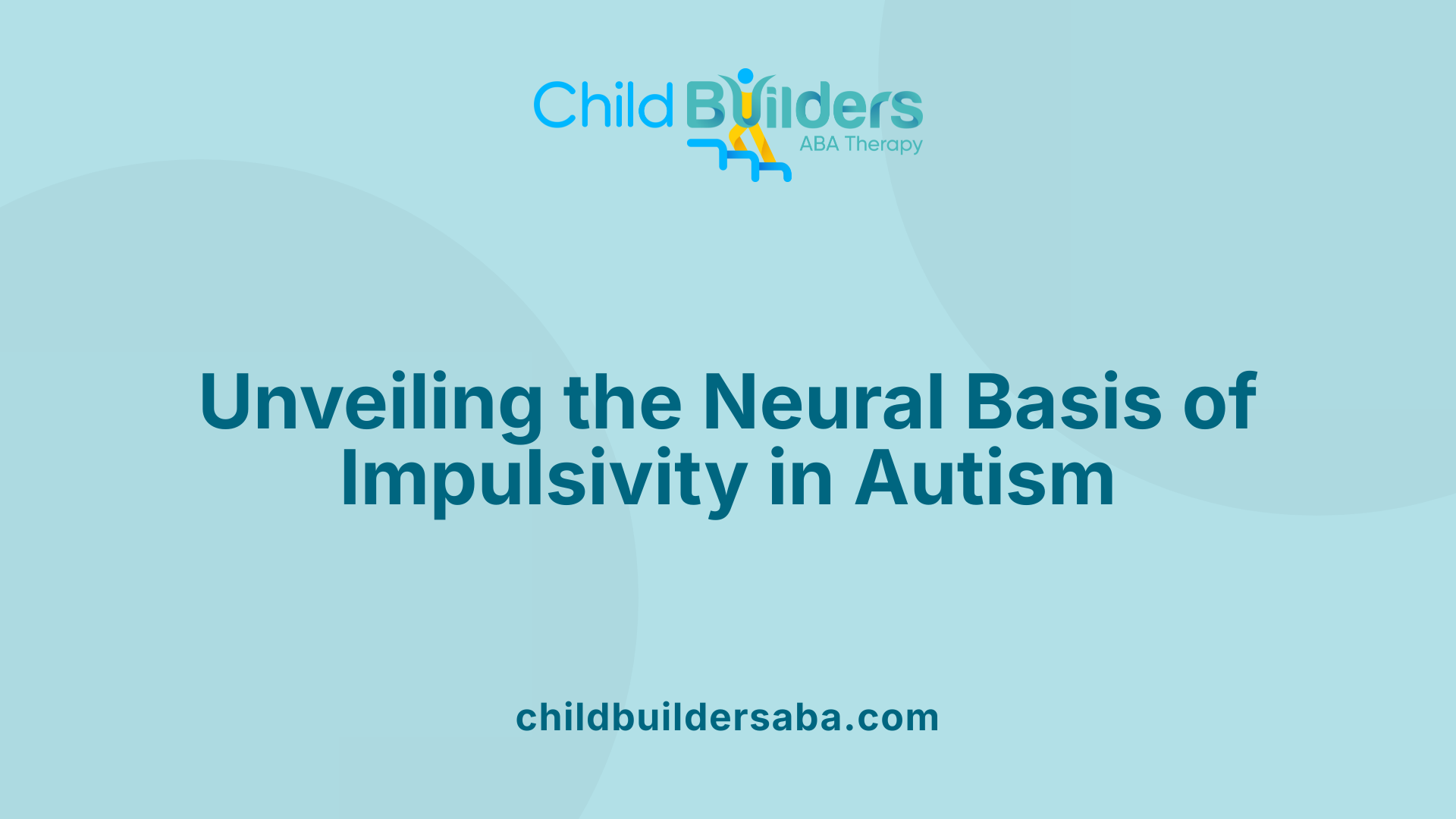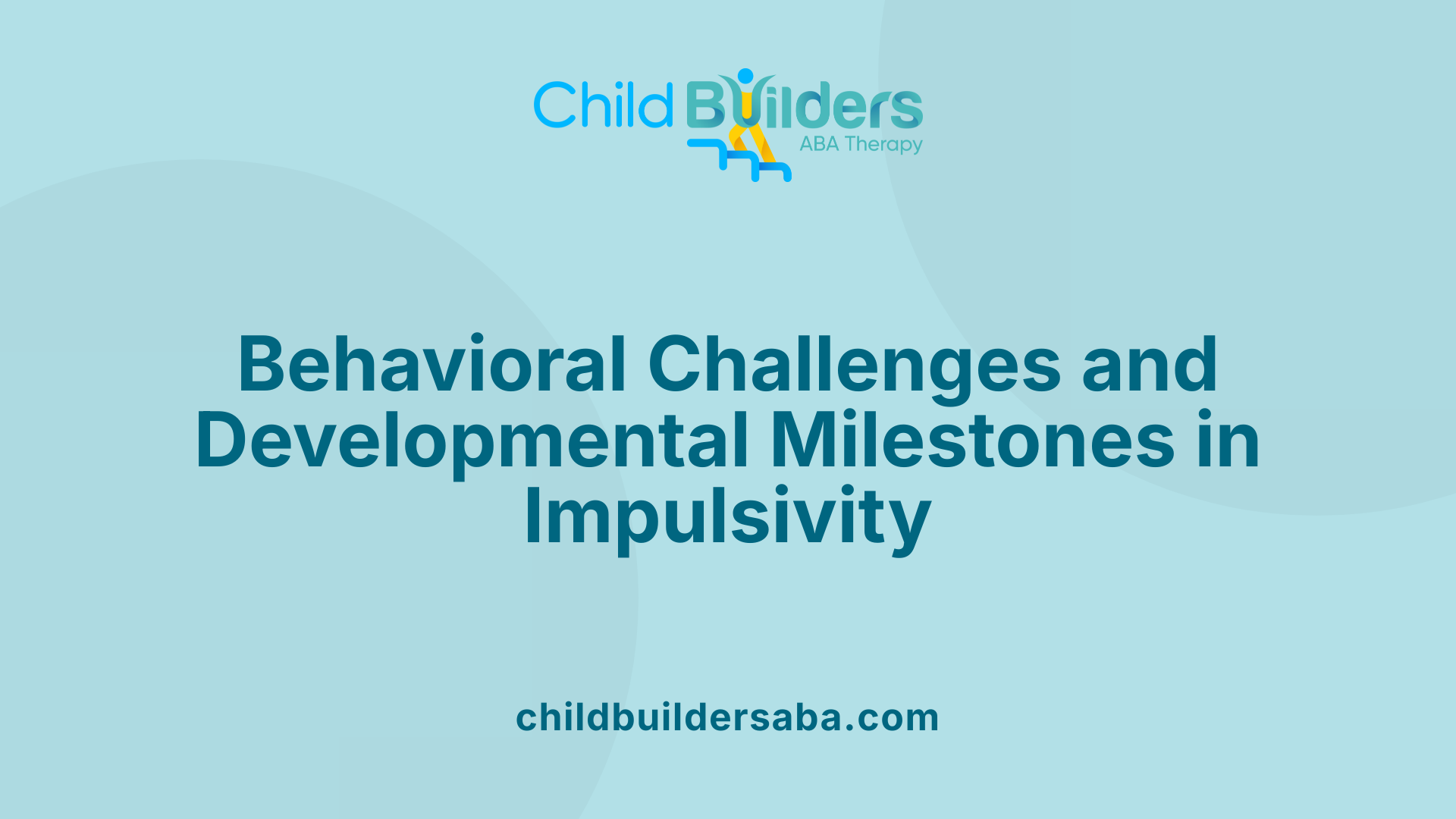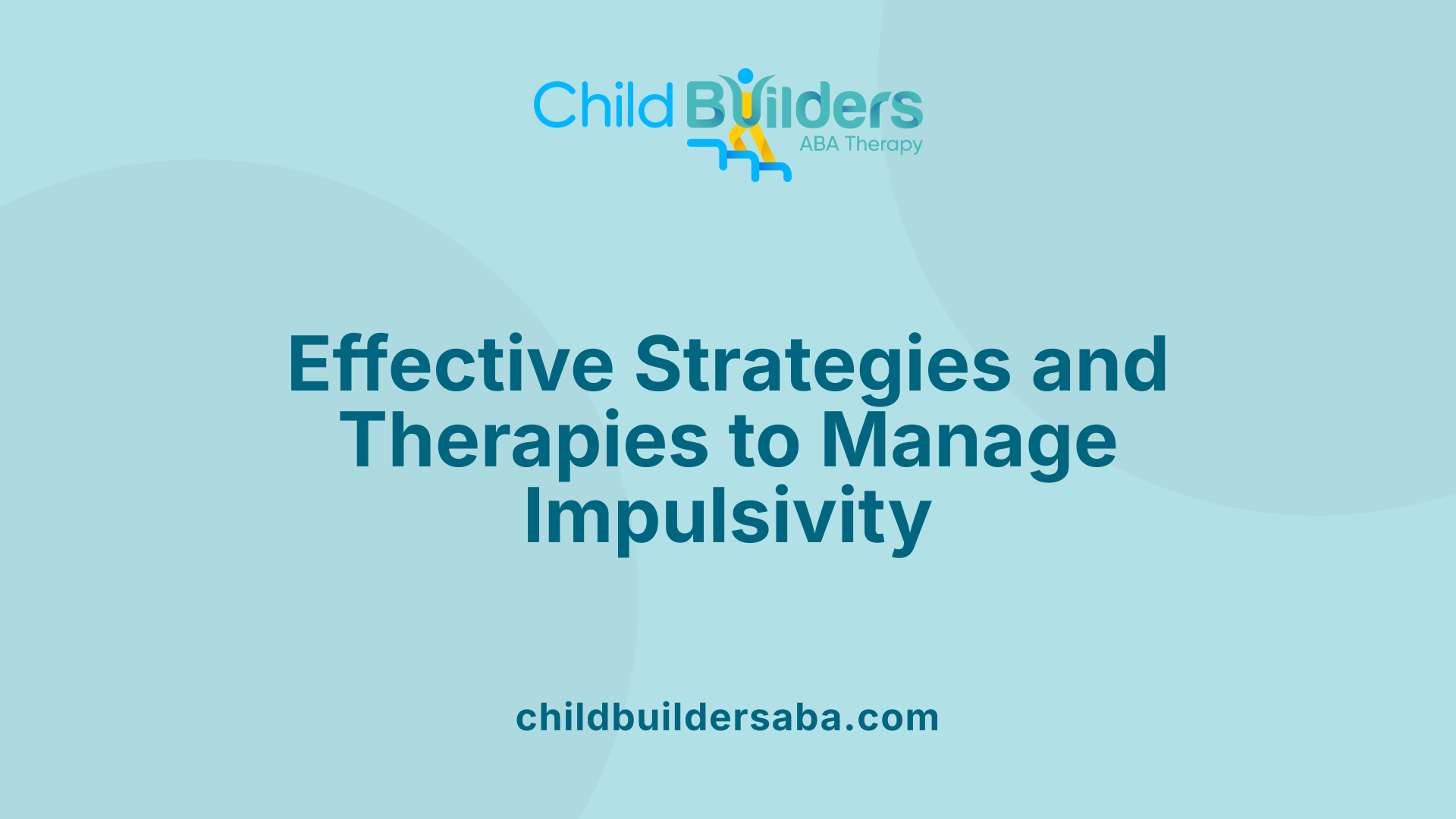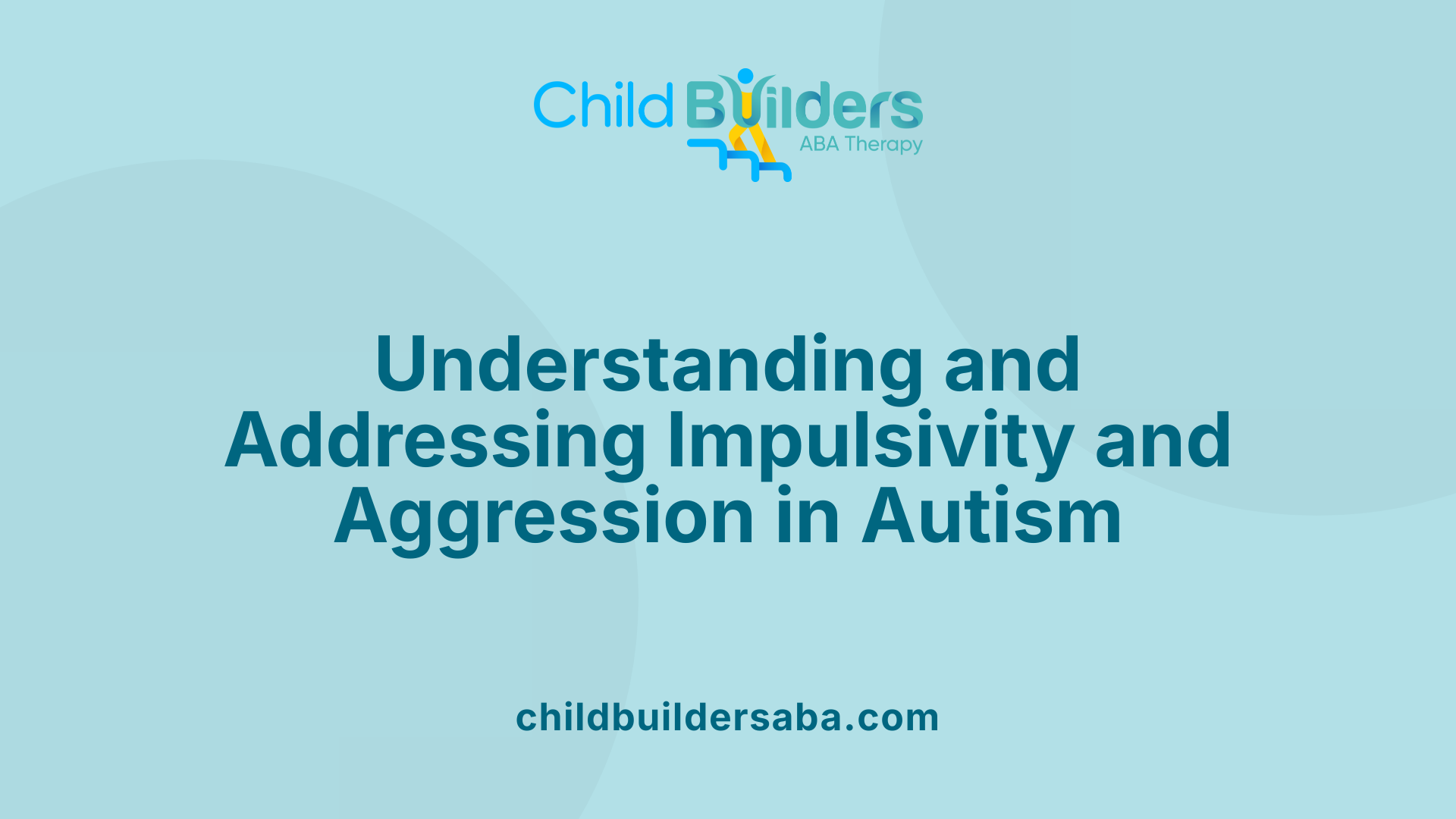Autism And Impulse Control

Introduction to Autism and Impulse Control Challenges
Autism Spectrum Disorder (ASD) encompasses a range of neurodevelopmental conditions characterized not only by social and communication difficulties but also by significant challenges with impulse control. These impulsivity issues, rooted in complex neural mechanisms and behavioral patterns, can profoundly impact daily functioning and social interactions. This article explores the neurobiological underpinnings, behavioral manifestations, and intervention strategies aimed at managing impulse control problems in autistic individuals, highlighting the importance of tailored, multidisciplinary approaches.
Neural Correlates and Underlying Mechanisms of Impulsivity in Autism

How are autism and impulse control issues related, and what neural mechanisms are involved?
Autism spectrum disorder (ASD) often includes challenges with impulse control, which are rooted in abnormalities within neural circuits responsible for executive functioning and emotional regulation. Central to these difficulties are brain regions such as the prefrontal cortex, especially the dorsolateral prefrontal cortex (DLPFC), which plays a role in decision-making and self-regulation. Studies have shown that the DLPFC exhibits reduced activation during tasks requiring impulse control, such as response inhibition and cognitive reappraisal.
Additionally, limbic system structures like the amygdala and nucleus accumbens are involved in processing emotions and reward, respectively. In individuals with autism, these areas sometimes display atypical activity, leading to heightened emotional responses and impulsive behaviors.
Neurochemical systems also influence impulse regulation. Disrupted signaling of neurotransmitters like GABA (gamma-Aminobutyric acid) and glutamate affects the brain's inhibitory capacity. Imbalances in these chemical systems impair response inhibition and motor timing, which are crucial components of effective impulse control.
Genetic and epigenetic factors contribute additional layers of complexity. Mutations impacting synaptic proteins and neurotransmitter systems can alter neural circuitry, resulting in affected regions not functioning optimally.
In summary, the interplay between atypical neural activity—particularly in prefrontal and limbic regions—and neurochemical imbalances underpins the impulse control difficulties seen in autism.
How does executive functioning relate to impulsivity in individuals with autism?
Executive functioning encompasses core cognitive processes such as planning, flexible thinking, working memory, and behavioral inhibition. Deficits in these areas are common in autism and significantly contribute to impulsive behaviors.
Specifically, impairments in response inhibition—our ability to pause and think before acting—and interference control—which involves resisting distractions—are closely linked to impulsivity. For example, autistic individuals may exhibit behaviors like interrupting conversations, wandering, or reacting emotionally without considering consequences.
Neuroimaging research shows that these deficits are associated with atypical activity in fronto-parietal networks, including the prefrontal cortex regions critical for inhibitory control. Variability in research findings partly results from differences in study samples, such as variations in age, intelligence, and comorbid conditions.
Importantly, these executive function impairments are often targeted in behavioral interventions. Therapy approaches aim to enhance skills like flexibility, self-awareness, and task initiation, which can help reduce impulsivity. Improving these cognitive processes allows individuals with autism to better regulate their responses, leading to fewer impulsive acts and better overall behavior.
In conclusion, executive dysfunction, particularly in inhibitory control, is a fundamental factor driving impulsivity in autism, and addressing these deficits can significantly improve behavioral outcomes.
Behavioral and Developmental Aspects of Impulsivity in Autism

What behavioral challenges related to impulsivity are common in children with autism, and how can they be addressed?
Children with autism frequently display impulsive behaviors, which can manifest as difficulty waiting their turn, interrupting conversations, or reacting abruptly to emotional stimuli. They may also engage in behaviors such as emotional outbursts, aggression, or self-injury. These behaviors often result from underlying issues such as deficits in response inhibition, challenges with executive functioning, sensory sensitivities, and difficulties in social communication.
Addressing impulsivity involves a comprehensive approach that combines behavioral interventions, therapeutic strategies, and, in some cases, medication. Applied Behavior Analysis (ABA) is particularly effective; it uses reinforcement techniques to teach self-regulation, social skills, and appropriate behavioral responses. Occupational therapy and speech therapy can improve sensory processing and communication skills, reducing triggers for impulsivity. Medications like stimulants, atomoxetine, atypical antipsychotics, or alpha2 adrenergic agonists may be prescribed to manage hyperactivity and related impulsive behaviors, depending on individual needs and safety considerations.
This integrated approach allows children to develop better emotional and social regulation skills, leading to fewer disruptive behaviors and improved interactions within their environment.
When and how does impulse control develop, and what is affected in autism?
Typically, impulse control begins to develop around ages 5 to 7, with foundational skills sometimes emerging as early as age 3. During this period, children gradually learn to pause before acting, weigh consequences, and regulate their emotional responses.
In children with autism, this developmental process can be delayed or follow an atypical course due to neurological differences impacting executive functioning. These deficits can hinder response inhibition, motor timing, and emotional regulation, impairing the child's ability to control impulses effectively.
Early intervention is vital. Therapies that focus on behavioral and cognitive skills, such as social skills training and sensory regulation strategies, can promote the development of impulse control. Structured routines, visual schedules, and routines provide stability and predictability, which are essential for supporting children in acquiring these skills.
Understanding the typical age range for impulse control development and recognizing the delays common in autism help caregivers and therapists tailor support programs. This targeted approach can improve impulse management as children grow, ultimately fostering greater independence and emotional regulation.
Coping Strategies and Therapeutic Interventions for Impulse Control in Autism

What are some self-regulation techniques helpful for individuals with autism to control impulses?
Self-regulation is crucial for managing impulsivity in autistic individuals. Techniques include sensory regulation strategies, where children might engage in sensory seeking behaviors like fidgeting or repetitive movements, or sensory avoidance to calm themselves.
Structured routines and visual supports such as social stories, emotion charts, and levels of alertness are effective tools to promote emotional awareness. Teaching children to recognize, label, and understand their emotions enhances emotional self-awareness, which is a stepping stone toward better impulse control.
Relaxation techniques—like deep breathing, progressive muscle relaxation, or using calming weighted objects—help manage heightened arousal levels that can lead to impulsivity.
Supporting self-soothing behaviors without judgment encourages children to develop healthy regulation habits. Additionally, providing predictable environments through visual schedules, timers, and checklists helps children anticipate transitions and reduce anxiety-driven impulsive responses.
Professional interventions, including cognitive-behavioral therapy (CBT) and occupational therapy, can further strengthen these skills. Overall, combining sensory strategies, visual supports, and emotional regulation techniques creates a comprehensive approach that fosters better impulse control.
What are effective strategies and interventions for managing impulse control difficulties in individuals with autism?
Effective management of impulsivity involves tailored behavioral and sensory interventions. Applied Behavior Analysis (ABA) remains one of the most researched and effective therapies, utilizing functional behavior assessments to identify triggers and reinforcement strategies to promote self-control.
Sensory regulation plays a key role. Sensory breaks and integrating sensory activities—such as swinging, textured objects, or calming sounds—can help soothe hyper-responsive sensory systems, reducing impulsive reactions.
Visual routines, including schedules with pictures and timers, help individuals understand upcoming transitions and prepare mentally, reducing anxiety and impulsive reactions.
Teaching coping mechanisms like deep breathing, mindfulness exercises, and role-playing social interactions can also improve self-awareness and delay impulsive responses.
Collaborating with specialists for social skills training and executive functioning support enhances an individual’s ability to regulate impulse-driven behaviors effectively, supporting independence and safety.
What strategies can be employed to reduce impulsive behavior in individuals with autism?
Reducing impulsivity often involves combining behavioral interventions with environmental adjustments. Establishing predictable routines using visual and auditory cues creates a stable environment that minimizes surprises and impulsive reactions.
Breaking complex tasks into smaller, clear steps with visual aids helps children focus on manageable goals, reducing the likelihood of impulsive actions driven by frustration.
Interventions like ABA utilize reinforcement and differential reinforcement strategies to encourage desirable behaviors and diminish impulsive, maladaptive actions.
In some cases, medication such as selective serotonin reuptake inhibitors (SSRIs) or risperidone may be prescribed to manage severe impulsivity or aggression, always under medical supervision.
Creating a sensory-friendly environment—reducing overstimulation and providing calming spaces—supports emotional regulation.
Visual Summary of Interventions for Impulse Control in Autism
| Strategy | Description | Example Tools/Applications |
|---|---|---|
| Behavioral Therapies | Use of reinforcement, functional assessments, and tailored interventions | ABA therapy, FBA, behavior intervention plans |
| Sensory Integration | Activities that help regulate sensory responses | Swinging, textured toys, calming sounds |
| Visual Supports | Visual aids to understand routines and emotions | Visual schedules, social stories, emotion charts |
| Social Skills Training | Developing communication and self-regulation skills | Role-playing, social stories, peer interactions |
This multi-faceted approach ensures strategies address various factors influencing impulsive behaviors, leading to improved self-control and safety in autistic individuals.
Challenges of Impulsivity and Aggression in Children with Autism

What behavioral challenges related to impulsivity are common in children with autism, and how can they be addressed?
Children with autism frequently exhibit impulsive behaviors that can affect their daily lives and social interactions. These behaviors include emotional outbursts, aggression, self-injury, rapid eating, and difficulty waiting their turn or transitioning between activities. Such impulsivity often results from deficits in response inhibition, executive functioning, sensory processing issues, and difficulties in understanding social cues.
To effectively address these challenges, a comprehensive approach is essential. Behavioral interventions like Applied Behavior Analysis (ABA) are widely used to teach self-regulation, patience, and social skills. These therapies involve reinforcing positive behaviors and developing routines that promote impulse control.
In addition to behavioral strategies, occupational and speech therapies can improve sensory integration and communication skills, making it easier for children to manage their impulses. Medication options, such as stimulants, atomoxetine, atypical antipsychotics, and alpha2 adrenergic agonists, can be considered to manage hyperactivity and impulsivity symptoms tailored to individual responses and safety considerations.
Ultimately, success relies on a mix of behavioral, therapeutic, and pharmacological interventions, all personalized to meet each child's unique needs.
How can impulsive aggression in autism be understood and managed?
Impulsive aggression among autistic individuals often stems from environmental stressors like loud noises or overwhelming settings that trigger frustration and emotional dysregulation. Recognizing these triggers is crucial for prevention and management.
Functional Behavior Analysis (FBA) is a valuable tool that helps caregivers and professionals understand the purpose behind aggressive episodes. By analyzing antecedents, behaviors, and consequences, FBA guides the development of tailored intervention plans.
Strategies to manage impulsive aggression include teaching functional communication skills so children can express their needs and frustrations appropriately. Reinforcement of positive behaviors and encouraging self-soothing activities, such as stimming (repetitive movements like hand-flapping), can help reduce aggression episodes.
Environmental modifications—like reducing noise or providing calm spaces—also minimize triggers. Additionally, sensory integration therapies can calm the nervous system, decreasing the likelihood of outbursts.
Overall, understanding that impulsive aggression often results from sensory overload or difficulty managing emotions allows caregivers to implement proactive strategies that reduce the frequency and intensity of such behaviors.
What intervention approaches are effective for managing impulsive aggression in children with autism?
Effective management of impulsive aggression in autistic children relies heavily on behavioral interventions such as ABA and FBA. These approaches focus on behavior assessment, identifying triggers, and establishing personalized intervention plans.
Reinforcement strategies within ABA aim to increase acceptable social behaviors and diminish problematic responses. For example, rewarding calm behavior and appropriate communication can discourage aggressive outbursts.
Functional Communication Training (FCT) is another crucial approach, teaching children to express their needs or frustrations verbally or through alternative communication methods. This reduces the likelihood of aggression arising from communication deficits.
Incorporating sensory activities, such as stimming or calming routines, offers sensory regulation that can prevent escalation. Adjustments to the environment, like minimizing loud noises or providing calming sensory input, support emotional regulation.
Training caregivers in these strategies ensures consistency, which is vital for success. The combined application of behavioral therapies, environmental modifications, and caregiver education creates a supportive framework that effectively manages impulsive aggression, improving social interactions and emotional well-being.
Managing Impulsivity in Autism: A Multimodal Approach

What strategies can be employed to reduce impulsive behavior in individuals with autism?
Reducing impulsive behaviors in autistic individuals involves a variety of strategies tailored to individual needs. Behavioral methods such as Applied Behavior Analysis (ABA) are widely used to reinforce desirable behaviors and discourage impulsive responses through structured reinforcement and consequence systems.
Sensory regulation techniques, including sensory diets and calming activities, help manage sensory overload, which can trigger impulsivity. Establishing predictable routines with visual cues or timers creates a structured environment, helping individuals understand expectations and reduce impulsivity.
Breaking down complex tasks into simple, manageable steps supports better self-control and decision-making. Visual aids, social stories, and scheduled activities serve as tools for fostering self-regulation.
In addition to behavioral strategies, professional guidance might include medication options, such as selective serotonin reuptake inhibitors (SSRIs) or risperidone, especially for severe cases or co-occurring conditions.
Creating an environment that minimizes sensory triggers, monitors environmental stressors, and enforces consistent consequences helps in managing impulsivity effectively.
How do therapies like ABA and social skills training support impulse control?
ABA therapy and social skills training are foundational in promoting impulse control in autistic individuals. ABA employs reinforcement techniques to teach self-regulation, help recognize triggers, and develop alternative responses. Through repeated practice and clear goal setting, individuals learn to pause, think, and act appropriately, which reduces impulsive reactions.
Social skills training complements ABA by teaching skills such as turn-taking, patience, and emotional regulation within social contexts. Role-playing, social stories, and group activities foster understanding of social cues and appropriate responses, directly reducing impulsivity during interactions.
Both therapies focus on structured learning environments, positive reinforcement, and developing purposeful behaviors. Over time, these strategies help individuals gain better control over their impulses, leading to improved emotional regulation and safer behaviors.
What is the significance of considering individual triggers and environmental factors in managing impulsivity?
Understanding and addressing individual triggers and environmental influences are critical for effective impulsivity management. Triggers such as loud noises, unexpected changes, or overwhelming sensory inputs can lead to impulsive reactions.
Personalized interventions that identify these triggers enable caregivers and therapists to develop tailored strategies. These may include sensory accommodations, visual schedules, calming spaces, or gradual exposure plans to reduce triggers.
Modifying environments—such as creating quiet zones or using visual supports—helps prevent impulsive outbursts by reducing stress and overstimulation. Recognizing personal preferences and sensitivities ensures that interventions are respectful and effective.
Ultimately, considering unique triggers and environmental factors allows for adaptive, person-centered approaches. This promotes emotional stability, safety, and better behavioral outcomes for individuals with autism.
Conclusion: Supporting Self-Regulation and Emotional Balance in Autism
What are the response inhibition issues seen in autistic individuals?
Patients with autism often experience challenges with response inhibition and interference control—core aspects of behavioral regulation. These difficulties make it hard for them to pause or suppress impulsive actions, leading to behaviors that might seem unregulated or spontaneous. Neuroimaging studies reveal that these inhibitory problems correlate with atypical activity in the fronto-parietal brain network, which includes regions like the inferior parietal lobule, anterior cingulate cortex (ACC), supplementary motor area (SMA), insula, and both dorsolateral and ventrolateral prefrontal cortices (DLPFC and VLPFC). These areas are crucial for controlling impulses and regulating behavior.
How does motor timing relate to impulse control?
Impaired motor timing, or the difficulty in coordinating movements in anticipation of future actions, is another aspect observed in individuals with autism. Such deficits can hinder their ability to respond appropriately in dynamic environments, further complicating efforts to develop self-regulation and impulse control.
Why do some inhibitory task studies show inconsistent results?
Research findings are sometimes conflicting; some studies do not find significant inhibitory deficits in autism. This inconsistency is largely due to heterogeneity across research samples—including variations in age, intelligence, medication use, and overall functioning levels—which can influence inhibitory performance. Hence, the underlying neurobiological and behavioral profiles can differ significantly among individuals.
What behaviors demonstrate impulsivity in autism?
Impulsivity manifests as behaviors like interrupting conversations, grabbing objects without permission, wandering, or reacting emotionally inappropriately. These behaviors are often linked to difficulties with emotional regulation, sensory sensitivities, and executive functioning challenges. For children, impulsivity might serve as an attempt to explore or test their environment, but it can result in disruptive or unsafe situations.
How does executive functioning relate to impulsivity?
Executive dysfunction in autism includes trouble initiating, planning, and regulating behaviors. These difficulties are associated with impulsivity because they impair the ability to pause and evaluate options—that's akin to pressing a 'pause' button before acting. Executive skills like working memory, cognitive flexibility, and self-awareness are essential for impulse control, and deficits here can lead to immediate reactions without thoughtful consideration.
Strategies for managing impulsivity in autistic children
Interventions focus on developing skills like self-regulation, flexibility, and awareness. Visual schedules, social stories, and behavioral activities help children learn to anticipate and control impulses. Techniques such as practicing patience, using timers or visual cues, role-playing scenarios, and employing cognitive-behavioral therapy (CBT) or Applied Behavior Analysis (ABA) are effective. These approaches teach children to recognize triggers, pause before acting, and respond more adaptively.
Why is impulse control development important?
Typically developing children start to improve impulse control around ages 5 to 7, with some early development as young as age 3. Developing this skill is critical; it allows children to make safer decisions, regulate emotions, and enhance social interactions. For children with autism, targeted strategies can accelerate or support this developmental trajectory.
How is impulsivity connected to behaviors like aggression and addiction?
Impulsive behaviors can include aggressive outbursts, which may be triggered by environmental stressors such as loud noises or changes in routine. Additionally, neurobiological factors and repetitive behaviors like stimming can contribute to impulsivity, which has been linked to a higher risk of substance use and addiction. Research shows individuals with autism—particularly those with higher IQs or comorbid conditions like ADHD—are more than twice as likely to develop alcohol or drug dependence.
What therapies help enhance impulse control?
Behavioral therapies, especially ABA and Functional Behavior Analysis (FBA), are effective. They identify triggers and functional purposes of impulsive behaviors and use reinforcement strategies to promote better regulation. Functional communication training helps individuals express needs more appropriately, reducing impulsive outbursts. Sensory integration techniques and social skills training also support emotional regulation.
How do sensory and emotional factors influence impulsivity?
Sensory sensitivities—like aversions to loud noises or bright lights—can increase stress and impulsivity. Emotional dysregulation, which includes difficulty managing frustration, anger, or anxiety, often exacerbates impulsive responses. Recognizing and addressing these factors through tailored interventions and coping strategies is essential.
What broader factors impact impulse control?
Not all individuals with autism display impulsivity equally; some have levels comparable to peers with ADHD, where impulsivity is a primary characteristic. Neurobiological studies suggest that deficits in the prefrontal cortex and connectivity issues across brain networks contribute to these behaviors. External factors such as environment, routine, and stress levels profoundly influence the severity and frequency of impulsive actions.
| Aspect | Description | Relevance to Autism |
|---|---|---|
| Brain Regions Involved | Inferior parietal lobule, ACC, SMA, insula, DLPFC, VLPFC | Underlying neurobiological basis of response inhibition issues |
| Behavioral Manifestations | Interrupting, grabbing, wandering, emotional outbursts | Observable signs of impulsivity |
| Intervention Strategies | ABA, sensory integration, social skills, CBT | Methods to improve self-regulation and impulse control |
| Developmental Timeline | Starts between ages 3-7 | Critical window for intervention |
| Co-occurring Factors | ADHD, sensory sensitivities, emotional dysregulation | Complicate impulse management |
Understanding these interconnected factors helps tailor effective support and intervention plans, fostering better self-regulation and emotional balance for autistic individuals.
Final Thoughts on Managing Impulsivity in Autism
Addressing impulse control challenges in autism requires a comprehensive, individualized approach that incorporates neurobiological understanding, behavioral strategies, and supportive therapies. Early intervention, tailored interventions such as ABA and social skills training, sensory regulation techniques, and medication when appropriate can significantly improve outcomes. Collaboration among caregivers, educators, and healthcare providers is essential to create supportive environments that foster emotional regulation and adaptive behaviors. Recognizing the neurodevelopmental complexity of autism underscores the importance of a multidisciplinary model in promoting social participation, safety, and quality of life for autistic individuals. Continued research and personalized support remain key in refining strategies to effectively manage impulsivity across the lifespan.
References
- Autism, impulsivity and inhibition a review of the literature
- Impulse Control Disorder and Autism: All You Need to Know
- 40 Activities to improve impulse control in Autism
- Examining The Relationship Between Autism & Impulse Control!
- Autism and Impulsive Aggression: All You Need to Know
- Autism's hidden habit - The Transmitter
- Link between autism and impulse control & how to regulate - Rula
- Expert Q&A: Understanding autism emotional regulation
- Self-Regulation Strategies For Children With Disabilities



.jpg)

































































































